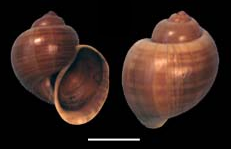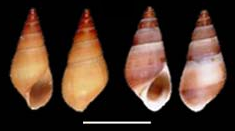Related Research Articles

The wildlife of Namibia is composed of its flora and fauna. Namibia's endangered species include wild dog, black rhino, oribi and puku.

Physella acuta is a species of small, left-handed or sinistral, air-breathing freshwater snail, an aquatic gastropod mollusk in the family Physidae. Common names include European physa, tadpole snail, bladder snail, and acute bladder snail. In addition, Physa acuta, Physa heterostropha and Physa integra are synonyms of Physella acuta.

Beddomeia fultoni(B. fultoni) is a species of small freshwater snail belonging to the family Tateidae.
Beddomeia phasianella is a species of very small freshwater snail that has a gill and an operculum, an aquatic operculate gastropod mollusk in the family Hydrobiidae. This species is endemic to Australia.
Beddomeia waterhouseae, also known as Claytons Rivulet freshwater snail, is a species of freshwater snail in the family Tateidae. This species is endemic to northern Tasmania in Australia. The holotype specimen was found in a very small tributary of Little Clayton's Rivulet and is held at the Australian Museum. B. waterhouseae is small and as an adult has a shell measuring between 1.7 to 3.7 mm in length. The shell shape is ovate-conic to broadly conic and has a thin inner lip and no columellar bulge. This species feeds on algae and detritus on rocks. The female of the species lay single eggs in capsules made of sand grains and attached to the underside of rocks or wood. B. waterhouseae is considered vulnerable by the IUCN as it has a very small range and is sensitive to water quality and so may be threatened by disturbances of its habitat. Other threats include habitat loss. Conservation activities such as assessment of the aquatic ecosystem and vegetal surveys are being undertaken in an attempt to preserve this species.

Pomacea is a genus of freshwater snails with gills and an operculum, aquatic gastropod mollusks in the family Ampullariidae, the apple snails. The genus is native to the Americas; most species in this genus are restricted to South America.

Pomacea diffusa, common name the spike-topped apple snail, is a species of freshwater snail, an aquatic gastropod mollusk in the family Ampullariidae, the apple snails.

Freshwater molluscs are those members of the Phylum Mollusca which live in freshwater habitats, both lotic such as rivers, streams, canals, springs, and cave streams and lentic such as lakes, ponds, and ditches.

Biomphalaria havanensis, common name the ghost rams-horn, is a species of air-breathing freshwater snail, an aquatic pulmonate gastropod mollusk in the family Planorbidae, the ram's horn snails.

Pomacea poeyana is a species of large freshwater snail with gills and an operculum, an aquatic gastropod mollusk in the family Ampullariidae, the apple snails.
Viviparus bermondianus is a species of a freshwater snail with gills and an operculum, an aquatic gastropod mollusk in the family Ampullariidae, the apple snails.
Nanivitrea helicoides is a species of small freshwater snail that has an operculum, an aquatic gastropod mollusk in the family Hydrobiidae.

Hemisinus brevis is a species of freshwater snail with an operculum, an aquatic gastropod mollusk in the family Thiaridae.

Hemisinus cubanianus is a species of freshwater snail with an operculum. It is an aquatic gastropod mollusk in the family Thiaridae.

Galba cubensis is a species of air-breathing freshwater snail, an aquatic gastropod mollusk in the family Lymnaeidae, the pond snails.

Around 1,300 species of freshwater crabs are distributed throughout the tropics and subtropics, divided among eight families. They show direct development and maternal care of a small number of offspring, in contrast to marine crabs, which release thousands of planktonic larvae. This limits the dispersal abilities of freshwater crabs, so they tend to be endemic to small areas. As a result, a large proportion are threatened with extinction.
Nanivitrea is a genus of small freshwater snails that have an operculum, aquatic gastropod mollusks in the family Hydrobiidae.

Hemisinus is a genus of freshwater snails with an operculum, aquatic gastropod mollusks in the family Hemisinidae.